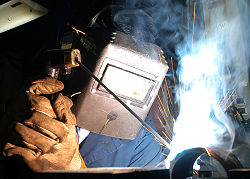Why do welders feel pain and irritation in the eyes at the end of the day.
Welding requires a lot of energy to melt or fuse the metals. Release of heat and energy can cause chemical and physical reactions. Welding produces ultraviolet, visible and infrared radiation at harmful levels.
These radiations and their secondary effects are responsible for the visual hazards. In general welding radiations of shorter wavelengths cause cornea problems whereas welding radiations of longer wavelengths cause biconvex.
Another chance of getting ‘arc-eye’ is my the smoke from the flash which is more harmful to the human eye it effects the eye layer causes red eye. Even the people who is with the welder to help him by holding or guiding gets this problem because smoke can spread in the air.
Welders will suffer a condition known as ‘arc-eye,’ a sensation of sand in the eyes and can occur even if exposure is limited to a few seconds of looking directly at a welding arc without eye protection.
This condition causes the cornea to swell and also can produce pain, sensitivity to light, and tearing. Repeated exposure can cause permanent eye damage. Cataracts also have been linked to long-term UV exposure.
How to cure?
First wash your eyes with cold water.
Use dilating drops.



